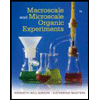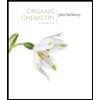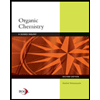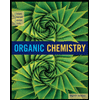
Interpretation:
The plane of symmetry, if any, is to be located in the given compounds and they are to be identified as chiral or achiral.
Concept introduction:
A chiral carbon atom is attached to four different atoms or groups of atoms.
In case of cyclic compounds, the chirality center is the carbon which is attached to two different groups, and the sequence of atoms around the ring from that carbon in clockwise direction must be different than that in counter clockwise direction.
A plane of symmetry bisects a molecule in two equal halves, which are mirror images of each other.
If a molecule possesses a center of symmetry or a plane of symmetry, it is superimposable on its mirror image. Then it is known to be an achiral molecule.
If a molecule has at least one chiral carbon atom and no elements of symmetry, then it is known to be a chiral molecule.
Trending nowThis is a popular solution!

Chapter 4 Solutions
CAREY: ORGANIC CHEMISTRY
- Using any data you can find in the ALEKS Data resource, calculate the equilibrium constant K at 25.0 °C for the following reaction. TiC₁₁(g) + 2H₂O(g) → TiO2 (s) + 4HCl (g) 4 Round your answer to 2 significant digits. K = ☐ x10 D Хarrow_forward: ☐ Х Draw an α amino acid with a hydroxyethyl (-CH2-CH2- OH) side chain. Draw the molecule as it would appear at physiological pH. Click and drag to start drawing a structure. 5 Parrow_forwardDraw the product of the reaction shown below. Ignore inorganic byproducts. cat. H2SO4 HNO3 (1 equiv) Drawing Qarrow_forward
- Provide the correct systematic name for the compound shown here.arrow_forwardUsing the appropriate bond energies, calculate the heat of reaction AH for the following reaction: H-H + CI-CI 2 H-CI You can find a table of bond energies by using the Data button on the ALEKS toolbar. Round your answer to the nearest kJ/mol. Note: For clarity, all lone pairs have been omitted from the molecular structures. ☐ kJ mol ค 000 Ar Barrow_forwardPredict the hydrocarbon, of formula C6H10, needed to prepare the following geminal dibromide upon treatment with excess hydrobromic acid. Note: The shown product is the only regioisomer formed in this reaction. HBr H₂C. CH3arrow_forward
- A mixture of CaCO3 and MgC2O4 of unknown mass was heated in a 0.5 L closed rigid vessel to 900 degrees C.at 400C the following reaction occurs:MgC2O4 -> MgO (s) + CO (g) + CO2 (g)At 700C a second reaction occurs: CaCO3 -> CaO (s) + CO2 (g)The solid mass in the vessel was measured to be 3.06 g at 400C and 2.03g at 900CQuestion: What is the partial pressure of CO in both temperatures? (400 and 900C), provide detailed explanation.arrow_forwardFor the following alkyne, complete the reaction sequentially (that is draw the intermediate that we can’t stop at) and then name (complete name) all 3 molecules.arrow_forwardGiven the reaction sequence below, answer the following. A. Provide the structure for A. B. Provide the structure for B (pay attention to stereochemistry). C. Provide the structure for C. D. What are the stereochemical designations for I and II (R/S)?arrow_forward
 Macroscale and Microscale Organic ExperimentsChemistryISBN:9781305577190Author:Kenneth L. Williamson, Katherine M. MastersPublisher:Brooks Cole
Macroscale and Microscale Organic ExperimentsChemistryISBN:9781305577190Author:Kenneth L. Williamson, Katherine M. MastersPublisher:Brooks Cole
 Organic Chemistry: A Guided InquiryChemistryISBN:9780618974122Author:Andrei StraumanisPublisher:Cengage Learning
Organic Chemistry: A Guided InquiryChemistryISBN:9780618974122Author:Andrei StraumanisPublisher:Cengage Learning Organic ChemistryChemistryISBN:9781305580350Author:William H. Brown, Brent L. Iverson, Eric Anslyn, Christopher S. FootePublisher:Cengage Learning
Organic ChemistryChemistryISBN:9781305580350Author:William H. Brown, Brent L. Iverson, Eric Anslyn, Christopher S. FootePublisher:Cengage Learning



